| July 2021 | MediGap Advisors Health & Wealth Newsletter | Vol. 17, Issue 7 |
Market Volatility is Coming: Here are 6 Ways to Protect Your Investments
Time to Sound the Alarm: Act Now to Protect Your Retirement Savings
As a financial planning expert, my job isn’t to sugar coat things. So I’m going to shoot straight on this one: the global financial markets are in a lot of trouble, and your retirement savings are at risk.
Consider this:
- American deficit spending is at an all-time high, with no signs of slowing
- Global supply chains are strained; Prices on everything from food to electronics are going up
- The housing market is out of control
- Billions of dollars of American currency has been converted to Bitcoin
Add to this list inflation, international trade wars, and run-amok government regulation, and you have one of the most chaotic, unpredictable financial environments that this country has ever seen.
Make no mistake: Market volatility is about to get a whole lot worse. If we’re going to protect our retirement plans, we need to make sure that our assets are in the right place.
Here are six ways to get started:
1. Maintain your safe investments (Cash & bonds)
One of the most simplistic ways to keep your money safe from market volatility: Keep it out of the market. Having secure cash savings and bonds can protect you from the big market swings.
However, you’ve always got to worry about inflation, and you’re likely not earning much on this portion. My advice is to keep a small but deliberate portion of your retirement assets in cash and bonds. Shoot for 15 – 25 %.
2. Invest in high-dividend mutual funds
In times of low interest rates, dividend-paying stocks are a great way to generate income with relatively low risk. Because the current yield on bonds is so low, high-dividend mutual funds like T. Rowe Price, Fidelity Equity, and Vanguard Utilities ETF (to name a few) are now potentially more profitable than ever.
3. Diversify
Splitting your assets in multiple investment types can minimize the risk of any individual negative event. For example, if everything you’ve got is invested in one place, a single market blip could cost you 30, 40, or even 50%. (Remember 2009?)
When diversifying your investments, consider things like:
- Asset type: Bonds, stocks, real estate, and commodities will all handle market volatility a little differently. Splitting by asset type can insulate against individual market events.
- Company size: Over long periods of time, small and large companies within the same industry will perform differently. If you’re investing in a specific industry, consider splitting your investment by company size, using total market cap as a starting point.
- Geographic: There are more markets to consider than just the one you’re living in. Spreading your investments across different regions and even countries is usually a good bet.
But remember: The whole point of diversification is to average out your total risk. That means that your income potential can be reduced as a result. The key is choosing the right amount of diversification based on your investment goals.
4. Put stop-loss orders on your Portfolio
If the stock market takes a sudden plunge when you’re not paying attention, there’s a chance that you could lose everything. In fact, it’s not all that uncommon.
A stop-loss order is a set of “automatic brakes” that is designed to protect your portfolio from an unexpected nosedive. This is a set of instructions to your broker that say exactly when, in terms of trading price, the stock or security should be sold.
Stop-loss orders can be placed on stocks, exchange-traded funds, and real-estate investment funds. They can be ordered for a single day, or “good-until-canceled”. However, stop-loss orders are not compatible with traditional mutual funds.
5. Consider a self-funded pension
If there’s one fool-proof way to guarantee income in retirement, it’s with a self-funded pension.
Here’s how it works: You take a certain portion of your liquid assets, and basically convert that into a monthly income payment that is set-aside for retirement. But unlike other investment strategies, self-funded pensions are guaranteed for life. That means that you’ll never have to worry about running out of money in retirement.
6. Work with an expert to create a bulletproof retirement plan
If you’re ready to get to work on your retirement strategy, or if you want to learn more about self-funded pensions, call your Personal Benefits Manager. We’ll work with you to make sure that you’re on the right track to a secure, full-picture retirement strategy.
Click here to schedule a free consultation. For even more retirement tips and strategies, click over to the MediGap Advisors Blog.
To your health and wealth,


Wiley P. Long, III
President – MediGap Advisors

